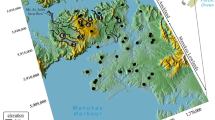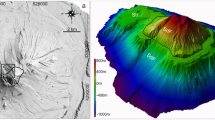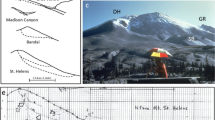Abstract
The upper flanks of stratovolcanoes usually exhibit steep slopes affected by fumarolic or hydrothermal activity. These conditions commonly promote rock instability, triggering rock avalanches and landslides. Quiescent and active stratovolcanoes transected by fractures and faults are further susceptible to these phenomenon, especially when they are located in tropical regions, where heavy rainfall regimes tend to saturate the volcanic material and promotes landslides. One example of such volcanoes is the Tacaná Volcanic Complex located at the Mexico-Guatemala border. It consists of three NE-SW aligned volcanoes (Chichuj, Tacaná, and San Antonio) and the Ardillas Dome. Just recently, the eastern portions of Ardillas Dome and San Antonio volcano have been affected by rockfalls and landslides toward the southern flank of the Complex, particularly to the Maxaum ravine. Field surveys showed tension fractures, landslide scars, fumaroles and volcanic vents along an important NE-SW fissure that has been growing between these two volcanic structures. To assess a future landslide within this zone, we delineate an area prone to collapse, according to the structural and morphometric analysis. We simulate a set of five gravitational flows of different volumes (1 × 105 to 2.5 × 107 m3) with the numerical code Titan2D varying the source area of the landslides. The simulated landslides showed that independently of the volume involved or source point of the landslide, it will be channeled within the Maxaum ravine and travel a maximum distance of up to 7 km from the source. The simulated flows moved at maximum velocities of ~ 41 m/s and were dispersed over a surface area of ~ 17 km2 with variable thicknesses (0.5–7 m at the affected villages). The most voluminous landslides (2.5 × 107 m3) will impact at least eight villages inhabited by ~ 2000 people on the southern flanks of the Complex. By analyzing the potential building damage caused by the largest simulated landslide (intensity index, IDF), two localities would have major structural damages in their dwellings and two would be completely destroyed; meanwhile, another three villages would suffer minor structural damages and one would experience minor sedimentation. Although the outcomes described here represent the first evaluation of small-volume landslide hazards at the Complex, specifically at the Ardillas Dome, our maps are useful tools for the preparedness for the Civil Protection authorities and the population at risk. Thus, a detailed landslide hazard assessment is needed, taking into account the present state of the Tacaná Volcanic Complex as well as the geologic and climatologic setting of the volcano, and a full stability analysis.











Similar content being viewed by others
Availability of data and materials
The data obtained from field campaigns, as well as the complete datasets used for simulations, can be shared if requested. Within the manuscript, the relevant values used for numerical modelling are described in the tables, and the data referenced in some of the sections could be consulted in the original papers referenced.
References
Alcalá-Reygosa J, Arce JL, Macías JL, Schimmelpfenning I, Saucedo R, Sánchez JM, Carlón T, Vázquez R, Cisneros-Máximo G, Jímenez A, Fernández S, Aster Team (2021) New chronologial constraints on intense Holocene eruptions and landslide activity at Tacaná volcanic complex (Mexico). Quat Geochronol. https://doi.org/10.1016/j.quageo.2021.101183
Alcántara-Ayala I, Garnica RJ (2013) Landslide monitoring and warning systems in Mexico. In: Sassa K, Rouhban B, Briceno S, McSaveney M, He B (eds) Landslides: global risk preparedness. Springer, Berlin, pp 301–316
Boomer JJ, Rodríguez CE (2002) Earthquake-induced landslides in Central America. Eng Geol 63:189–220
Böse E (1902) Breve noticia sobre el estado actual del Volcán Tacaná, Chiapas. Memorias De La Sociedad Científica Antonio Alzate 18:266–270
Cailleau B, LaFemina PC, Dixon TH (2007) Stress accumulation between volcanoes: an explanation for intra-arc earthquakes in Nicaragua? Geophys J Int 169:1132–1138
Capra L, Macías JL, Scott KM, Abrams M, Garduño-Monroy VH (2002) Debris avalanches and debris flows transformed from collapses in the Trans-Mexican Volcanic Belt, Mexico—behavior, and implications for hazard assessment. J Volcanol Geotherm Res 113:81–110
Carlón-Allende T, Macías JL, Mendoza ME, Villanueva Díaz J (2020) Evidence of volcanic activity in the growth rings of trees at Tacaná volcano, Mexico-Guatemala border. Can J Res 50:65–72
Charbonnier SJ, Palma JL, Ogburn S (2015) Application of “shallow-water” numerical models for hazard assessment of volcanic flows: The case of Titan2D and Turrialba volcano (Costa Rica). Rev Geo Am Centr 52:107–128
Coviello V, Capra L, Norini G, Dávila N, Ferrés D, Márquez-Ramírez VH, Pico E (2020) Earthquake-induced debris flows at Popocatépetl Volcano, Mexico. Earth Surf Dyn Discus, European Geosciences Union Preprint, p 24
De la Cruz-Reyna S, Armienta MA, Zamora V, Juárez F (1989) Chemical changes in spring waters at Tacaná Volcano, Chiapas, México. J Volcanol Geotherm Res 38:345–353
Demant A (1978) Características del Eje Neovolcánico Transmexicano y sus problemas de interpretación. Rev Int Geol UNAM México 2:172–186
DeMets C, Gordon RG, Argus DF, Stein S (1990) Current plate motions. Geophys J Int 101:425–478
Devoli G, De Blasio FB, Elverhøi A, Høeg K (2009) Statistical analysis of landslide events in Central America and their run-out distance. Geotech Geol Eng 27:23–42
Fitz N (2019) Evalución del peligro volcánico por avalanchas de escombros empleando modelación numérica, del Volcán Tacaná, Chiapas. Dissertation, Universidad Autónoma de Guerrero
García E (2004) Modificaciones al Sistema de Clasificación Climática de Köppen. Universidad Nacional Autónoma de México, Inst Geo, México, p 98
García-Palomo A, Macías JL, Arce JL, Mora JC, Hughes S, Saucedo R, Espíndola JM, Escobar R, Layer P (2006) Geological evolution of the Tacaná Volcanic complex, México-Guatemala. In: Rose WI, Bluth GJS, Carr MJ, Ewert JW, Patino LC, Vallance JW (eds) Natural hazards in Central America. Geol Soc Am Spec Pap vol 412, pp 39–57
Garduño-Monroy VH, Corona-Chávez P, Israde-Alcantara I, Arreygue E, Bigioggero B, Chiesa S (1999) Carta geológica de Michoacán, scale 1:250,000. Universidad Michoacana de San Nicolás de Hidalgo
Global Volcanism Program (1997) Report on Adams (United States) (Wunderman R Ed). Bull Global Volc Net 22:9. Smithsonian Institution. https://doi.org/10.5479/si.GVP.BGVN199709-321040
Gómez A (2021) Deslave en Unión Juárez, Chiapas, deja un muerto. Diario del Sur. https://twitter.com/diariosur_oem
Guzmán-Speziale M, Valdés-González C, Molina E, Gómez JM (2005) Seismic activity along the Central America volcanic arc: It is related to subduction of the Cocos plate? Tectonophys 400:241–254
Hayashi JN, Self S (1992) A comparison of pyroclastic flow and debris avalanche mobility. J Geophys Res 97(B6):9063–9071
IEA (2013) Instituto Estatal del Agua, Gobierno de Chiapas. In: Programa Regional de Desarrollo 2013–2018. Región X Soconusco, p 79
INEGI (2020) Censo de población y vivienda 2020. Instituto Nacional de Estadística, Geografía e Informática. https://www.inegi.org.mx/app/mapa/espacioydatos/?temind=268,123,1002000001
Jakob M, Stein D, Ulmi M (2012) Vulnerability of buildings to debris flow impact. Nat Haz 60:241–261
Kerle N, van Wyk de Vries B (2001) The 1998 debris avalanche at Casita volcano, Nicaragua—investigation of structural deformation as the cause of slope instability using remote sensing. J Volcanol Geotherm Res 105:49–63
Macías JL, Espíndola JM, García-Palomo A, Scott KM, Hughes S, Mora JC (2000) Late Holocene Peléan-style eruption at Tacaná volcano, Mexico and Guatemala: past, present, and future hazards. GSA Bull 112(8):1234–1249
Macías JL, Arce JL, García-Palomo A, Mora JC, Layer PW, Espíndola JM (2010) Late-Pleistocene flank collapse triggered by dome growth at Tacaná volcano, México-Guatemala, and its relationship to the regional stress regime. Bull Volcanol 72:33–53
Macías JL, Arce JL, Layer PW, Saucedo R, Mora JC (2015) Eruptive history of the Tacaná Volcanic Complex. In: Scolamacchia T, Macías JL (eds) Active volcanoes of Chiapas (Mexico): El Chichón and Tacaná. Active volcanoes of the world. Springer, Berlín, pp 115–138
Macías JL, Arce JL, Capra L, Saucedo R, Sánchez-Núñez JM (2018) Late formative flooding of Izapa after an eruption of Tacaná volcano. Anc Mesoam 29(1):361–371
Malfait BT, Dinkelman MG (1972) Circum-Caribbean tectonic and igneous activity and the evolution of the Caribbean Plate. Geol Soc Am Bull 83:251–272
McGuire WJ (1996) Volcano instability: a review of contemporary themes. In: McGuire WJ, Jones AP, Neuberg J (eds) Volcano instability on the earth and other planets. GeolSoc Spec Pub vol 110, pp 1–23
Mercado R, Rose WI (1992) Reconocimiento geológico y evaluación preliminar de peligrosidad del Volcán Tacaná, Guatemala/México. Geofís Int 31:205–237
Molnar P, Sykes LR (1969) Tectonics of the Caribbean and Middle America regions from focal mechanisms and seismicity. Geol Soc Am Bull 80:1639–1684
Mora JC, Macías JL, García-Palomo A, Arce JL, Espíndola JM, Manetti P, Vaselli O, Sánchez M (2004) Petrology and geochemistry of the Tacaná Volcanic Complex, Mexico-Guatemala: evidence for the last 40 000 yr of activity. Geof Int 43:331–359
Mora JC, Gardner JE, Macías JL, Meriggi L, Santo AP (2013) Magmatic control son eruption dynamics of the 1950 yr B.P. eruption of San Antonio Volcano, Tacaná Volcanic Complex. Mexico-Guatemala J Volcanol Geotherm Res 262:134–152
Mülleried FKG (1951) La reciente actividad del volcán Tacaná, Estado de Chiapas, a fines de 1949 y principios de 1950. Informe del Instituto de Geología de la UNAM 28
Ortega-Flores B, Martini M, Solari L, Colás V, Guerrero-Moreno S, Centeno-García E, Silva-Romo G, Grajales-Nishimura M (2019) Reply to Molina-Garza et al. (2019) “Discussion of: Ortega-Flores et al. (2018) provenance análisis of Oligocene sandstone from the Cerro Pelón area, southern Gulf of Mexico”. Int Geol Rev. https://doi.org/10.1080/00206814.2019.1616621
Patra AK, Bauer AC, Nichita CC, Pitman EB, Sheridan MF, Bursik MI, Rupp B, Webber A, Stinton AJ, Namikawa L, Renschler C (2005) Parallel adaptive numerical simulation of dry avalanches over natural terrain. J Volcanol Geotherm Res 139:1–21
Pitman EB, Nichita CC, Sheridan MF, Patra AK, Bauer AC, Bursik MI (2003) Computing granular avalanches and landslides. Phys Fluids 15:3638
Plafker G, Ericksen GE (1978) Nevados Huascarán avalanches, Peru. In: Voight B (ed) Rockslides and Avalanches, 1, Natural Phenomena. Dev Geotech Eng 14ª:277–314
Pola A, Macías JL, Garduño-Monroy VH, Osorio-Ocampo S, Cardona-Melchor S (2014) Successive collapses of the El Estribo volcanic complex in the Pátzcuaro Lake, Michoacán, Mexico. J Volcanol Geotherm Res 289:41–50
Rebollar CJ, Espíndola VH, Uribe A, Mendoza A, Pérez VA (1999) Distributions of stresses and geometry of the Wadati-Benioff zone under Chiapas, Mexico. Geofis Int 38(2):95–106
Rodríguez-Lomelí AG, García-Mayordomo J (2019) Seismic hazard at triple plate junction: the state of Chiapas (México). J Int Soc Prev Mit Nat Haz 97 (3), 17:1297–1325
Rowet D, Inguaggiato S, Taran T, Varley N (2009) Chemical and isotopic compositions of thermal springs, fumaroles and bubbling gases at Tacaná Volcano (Mexico-Guatemala): implications for volcanic surveillance. Bull Volcanol 71:319
Salvatici T, Di Roberto A, Di Traglia F, Bisson M, Morelli S, Fidolini F, Bertagnini A, Pompilio M, Hungr O, Casagli N (2016) From hot rocks to glowing avalanches: numerical modelling of gravity-induced pyroclastic density currents and hazard maps at the Stromboli volcano (Italy). Geomorphol 273:93–106
Saucedo R, Macías JL, Sarocchi D, Bursik M, Rupp B (2008) The rain-triggered Atenquique volcaniclastic debris flow of October 16, 1995 at Nevado de Colima Volcano, Mexico. J Volcanol Geotherm Res 173:69–83
SEMARNAT-CONANP (2013) Programa de manejo Reserva de la Biósfera Volcán Tacaná. Secretaría de Medio Ambiente y Recursos Naturales, Comisión Nacional de Áreas Naturales Protegidas, 1° Ed. 2013, 208 pp
Scott KM, Macías JL, Naranjo JA, Rodríguez S, McGeehin JP (2001) Catastrophic debris flows transformed from landslides in volcanic terrains: mobility, hazard assessment, and mitigation strategies. UStat Geol Surv Prof Pap 1630, p 72
Scott KM, Vallance JW, Kerle N, Macías JL, Strauch W, Devoli G (2005) Catastrophic precipitation-triggered lahar at Casita volcano, Nicaragua: occurrence, bulking and transformation. Earth Surf Proc Land 30:59–79
Schaefer LN, Oommen T, Corazzato C, Tibaldi A, Escobar-Wolf R, Rose WI (2013) An integrated field-numerical approach to assess slope stability hazards at volcanoes: the example of Pacaya, Guatemala. Bull Volcanol 75:720
Schaefer LN, Lu Z, Oommen T (2015) Dramatic volcanic instability revealed by InSAR. Geol Geol Soc Am 43(8):743–746
Schaefer LN, Di Traglia F, Chaussard E, Zhong Lu, Nolesini T, Casagli N (2019) Monitoring volcano slope instability with Synthetic Aperture Radar: A review and new data from Pacaya (Guatemala) and Stromboli (Italy) volcanoes. Earth Sci Rev 192:236–257
Siebert L (1984) Large volcanic debris avalanches: Characteristics of source areas, deposits, and associated eruptions. J Volcanol Geotherm Res 22:163–197
Siebert L, Glicken H, Ui T (1987) Volcanic hazards from Bezymianny- and Bandai-type eruptions. Bull Volcanol 49:435–459
Siebert L, Kimberly P, Pullinger CR (2004) The voluminous Acajutla debris avalanche from Santa Ana volcano, western El Salvador, and comparison with other Central American edifice-failure events. In: Rose WI, Boomer JJ, Lopez DL, Carr ML, Major JJ (eds) Natural hazards in El Salvador. Geol Soc Am Spe Pap 375:5–23
Siebert L, Alvarado GE, Vallance JW, van Wyk de Vries B (2006) Large-volume volcanic edifice failures in Central America and associated hazards. In: Rose WI, Bluth GJS, Carr MJ, Ewert JW, Patino LC, Vallance JW (eds) Volcanic hazards in Central America. Geol Soc Am Spe Pap 412:1–26
Ui T (1983) Volcanic dry avalanche deposits—identification and comparison with non volcanic debris stream deposits. J Volcanol Geotherm Res 18:135–150
Ui T, Yamamoyo H, Susuki-Kamata K (1986) Characterization of debris avalanche deposits in Japan. J Volcanol Geotherm Res 29:231–243
Vargas S, Mollard E (2005) Problemas socio-ambientales y experiencias organizativas en las cuencas de México, México. Inst MexTec Agua 386 pp
Vázquez R, Macías JL, Arce JL, Cisneros G, Saucedo R (2019) Numerical simulation of block-and-ash flows for different eruptive scenarios of the Tacaná Volcanic Complex, México-Guatemala. J Volcanol Geotherm Res 373:36–50
Vázquez R, Macías JL, Arce JL (2021) Integrated hazard maps of the Tacaná Volcanic Complex, Mexico-Guatemala: Ashfall, block-and-ash flows, and lahars. J South Am Earth Sci 107:103146
Voight B, Pariseau WG (1978) Rockslides and avalanches: An introduction. In: Voight B (ed) Rockslides and avalanches, 1, natural phenomena. Dev Geotech Eng 14A:1–67
Waythomas CF (2012) Landslides at stratovolcanoes initiated by volcanic unrest. In: John J, Clague Douglas Stead (eds) Landslides: types, mechanisms and modeling. Cambridge University Press, Cambridge, pp 37–49
White RA (1984) Catalog of historic seismicity in the vicinity of the Chixoy-Polochic and Motagua faults, Guatemala. U Stat Geol Surv Open-File Rep 84–88 34 pp
White RA, Harlow DH (1993) Destructive upper-crustal earthquakes of Central America since 1900. Seismol Soc Am Bull 38:1115–1142
Williams SN, Self S (1983) The October 1902 Plinian eruption of Santa María volcano, Guatemala. J Volcanol Geotherm Res 16(1–2):33–56
Acknowledgements
This work was supported by the Consejo Nacional de Ciencia y Tecnología (CONACyT) project PN522 and Dirección General de Asuntos del Personal Académico (DGAPA) project IN112720 to J.L. Macías. The authors thank the head of the Laboratorio Interinstitucional de Análisis de Riesgos, Guillermo Cisneros for his technical support on the cartographic material. We thank Néstor Fitz, for the numerical simulations performed to calibrate the model. We also thank students and colleagues whom shared fieldwork with us during this project and through the years. The English language was revised by Grant George Buffett (http://www.terranova.barcelona). Finally, we are very thankful to the anonymous reviewers who revised this paper with their objective suggestions because their observations enhanced the quality of this work.
Funding
This work was supported by the Consejo Nacional de Ciencia y Tecnología (CONACyT) project PN522 and Dirección General de Asuntos del Personal Académico (DGAPA) project IN112720 to J.L. Macías.
Author information
Authors and Affiliations
Contributions
All authors contributed to the study conception and design of this manuscript. Field work and data collection were performed by all authors. The sampling and 36Cl cosmic-ray exposure analysis was performed by Jesús Alcalá-Reygosa and José Luis Arce. The geological information was described by Ricardo Saucedo. The design of thematic maps was performed by Salvador Fernández. The landslide modeling was performed by Rosario Vázquez. Structural analysis was managed by Adrián Jiménez-Haro. Bioclimatic and morphometric analysis were performed by Teodoro Carlón, Salvador Fernández, Jesús Manuel Sánchez-Núñez and Rosario Vázquez. The first draft of the manuscript was written by Rosario Vázquez and all authors commented on posterior versions of the manuscript, after the first draft. The second draft of the manuscript was corrected and supervised by José Luis Macías, José Luis Arce and Jesús Alcalá-Reygosa. All authors read and approved the final manuscript.
Corresponding author
Ethics declarations
Conflict of interest
The authors have no conflicts of interest to declare that are relevant to the content of this article.
Additional information
Publisher's Note
Springer Nature remains neutral with regard to jurisdictional claims in published maps and institutional affiliations.
Rights and permissions
About this article
Cite this article
Vázquez, R., Macías, J.L., Alcalá-Reygosa, J. et al. Numerical modeling and hazard implications of landslides at the Ardillas Volcanic Dome (Tacaná Volcanic Complex, Mexico-Guatemala). Nat Hazards 113, 1305–1333 (2022). https://doi.org/10.1007/s11069-022-05348-1
Received:
Accepted:
Published:
Issue Date:
DOI: https://doi.org/10.1007/s11069-022-05348-1




